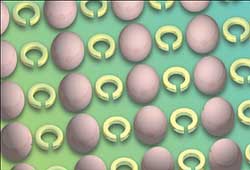Engineered materials: Custom-made magnets

An array of metamolecules comprising silicon spheres and copper split-rings can be used to control magnetization waves.<br>Copyright : © 2012 American Chemical Society<br>
The properties of a substance are largely dependent on its constituent atoms and the way that these atoms interact with each other. The finite number of atom types, however, imposes a limit on the range of properties that a conventional material can have.
In contrast, a new class of engineered materials called metamaterials have no such limitation. Metamaterials are typically composed of an array of nanostructures that can interact with electromagnetic waves in much the same way as atoms. In addition, the optical properties of these metamaterials can be tuned by altering the size and shape of nanostructures.
An international team of researchers led by Boris Luk'yanchuk at the A*STAR Data Storage Institute have now extended the properties and potential uses of metamaterials by using not one but two very different classes of nanostructures, or metamolecules.
Luk'yanchuk and the team mathematically modelled a two-dimensional array of metamolecules comprising a silicon sphere next to a partially incomplete copper ring. They studied the influence of both the sphere and the split ring on the magnetic component of an incident electromagnetic wave — a property known as magnetization.
“When the two structures were more than one micrometer apart, they both acted to increase the local magnetic field,” says Luk’yanchuk. However, they started to interact when moved closer together, and the researchers observed that the magnetization of the split ring decreases and even becomes negative for separations smaller than 0.5 micrometers.
This situation is somewhat analogous to the magnetic ordering in ‘natural’ materials. When all the atoms contribute in a positive way to a material’s magnetic properties, the material becomes a ferromagnet. However, when alternating regions of the material have opposite magnetization, the material is said to be antiferromagnetic.
“We demonstrate that our hybrid lattices of metamolecule exhibit distance-dependent magnetic interaction, opening new ways for manipulating artificial antiferromagnetism with low-loss materials,” explains Luk'yanchuk.
Although the analogy between metamaterials and magnetic materials is not a perfect one, most metamaterials are said to be ferromagnet-like. The design proposed by Luk'yanchuk and the team closely mimics antiferromagnetic ordering, and this opens an opportunity for researchers to study antiferromagnetic phenomena in metamaterials. One notable example is giant magnetoresistance, a phenomenon that is at the heart of modern electronic memories.
Luk'yanchuk affirms that a metamaterial analog would offer exciting research prospects. “We believe that our work has the potential to make a strong impact towards the development of on-chip integrated solutions for reconfigurable and optically-controlled metamaterials.”
The A*STAR-affiliated researchers contributing to this research are from the Data Storage Institute.
References:
Miroshnichenko, A. E., Luk'yanchuk, B., Maier, S. A. & Kivshar, Y. S. Optically induced interaction of magnetic moments in hybrid metamaterials. ACS Nano 6, 837–842 (2012).
Media Contact
All latest news from the category: Materials Sciences
Materials management deals with the research, development, manufacturing and processing of raw and industrial materials. Key aspects here are biological and medical issues, which play an increasingly important role in this field.
innovations-report offers in-depth articles related to the development and application of materials and the structure and properties of new materials.
Newest articles

“Nanostitches” enable lighter and tougher composite materials
In research that may lead to next-generation airplanes and spacecraft, MIT engineers used carbon nanotubes to prevent cracking in multilayered composites. To save on fuel and reduce aircraft emissions, engineers…

Trash to treasure
Researchers turn metal waste into catalyst for hydrogen. Scientists have found a way to transform metal waste into a highly efficient catalyst to make hydrogen from water, a discovery that…

Real-time detection of infectious disease viruses
… by searching for molecular fingerprinting. A research team consisting of Professor Kyoung-Duck Park and Taeyoung Moon and Huitae Joo, PhD candidates, from the Department of Physics at Pohang University…





















